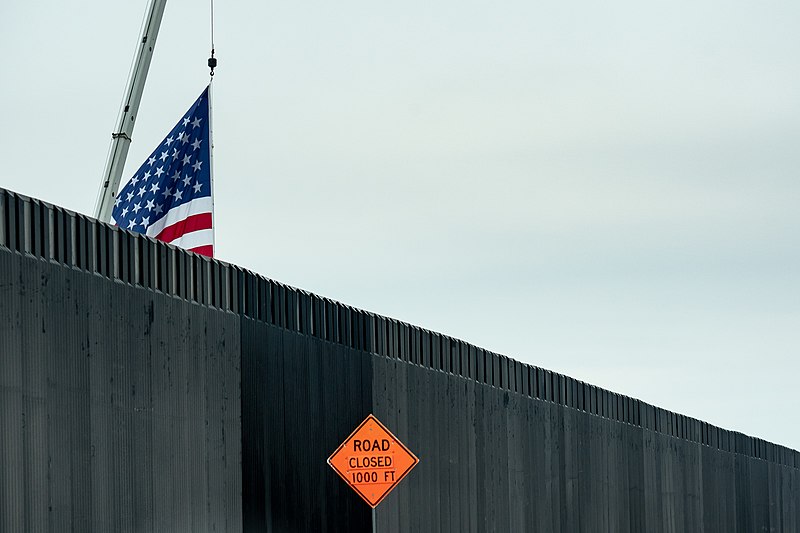- 14 3402-5578
- Rua Hygino Muzy Filho, 737, MARÍLIA - SP
- contato@latinoobservatory.org
 https://www.flickr.com/photos/whitehouse45/50832078386/
https://www.flickr.com/photos/whitehouse45/50832078386/
A private wall built along the Rio Grande in south Texas could collapse during extreme flooding, according to an inspection report commissioned by the federal government that has so far sought to keep it secret for more than a year.
The 404-page report, produced by the global engineering firm Arcadis, confirms previous reporting from ProPublica and The Texas Tribune. It also shows for the first time that the federal government independently found structural problems with the border fencing before reaching a settlement agreement with the builder, Fisher Industries, in May.
“Under the agreement, which ended a nearly three-year legal battle between the International Boundary and Water Commission and Fisher Industries, the company must inspect the fence quarterly, remove bollards and maintain a gate that would allow for the release of floodwaters. It must also keep a $3 million bond, a type of insurance, to cover any expenses in case the structure fails. Engineering and hydrology experts told the news organizations the bond is inadequate to cover the kind of catastrophic failure described by Arcadis and raised concerns that the federal government’s decision to settle the case cuts against the report’s findings”, according to TexasTribune.
According to the report, the wall does not meet basic international building codes and industry standards and has a much shallower foundation than border barriers built by the federal government.
Mark Courtois, an attorney for Fisher Industries, said that the construction company “strongly disagreed with the opinions in the Arcadis report and refuted those opinions to the satisfaction of the IBWC”. He said the company worked with the IBWC, which is charged with oversight of the international treaty, to “reach a mutually agreeable resolution of all matters pertaining to the fence, including any issues raised by the Arcadis report”.
The 3-mile project was completed in February 2020, making it the first border fence built directly on the riverbank in South Texas. We Build the Wall contributed about $1.5 million of the $42 million total cost, with the rest coming from Fisher, according to court testimony.
“The areas around the private border fence soon started to show signs of erosion. Six hydrologists and engineers told ProPublica and the Tribune in July 2020 that the foundation of the fence was too shallow and that a series of ravines and gullies where rainwater runoff had scoured the sandy loam beneath the foundation raised stability concerns”.
“Tommy Fisher, president of Fisher Industries, started to construct the fence in 2019 with financial support from the online fundraising campaign We Build the Wall. The nonprofit was set up to help former President Donald Trump build his “big, beautiful wall” along the length of the border. In the end, four of the nonprofit’s top leaders, including Trump’s former adviser Steve Bannon, were arrested on fraud and other charges connected to the fundraising scheme”, according to the Texas Tribune.
Shortly after construction of the wall began, the U.S. Department of Justice (DOJ) filed a lawsuit in federal court to try to stop the work, alleging that Fisher Industries was violating the treaty with Mexico. A Hidalgo County district judge granted the government a temporary restraining order to halt construction, but a federal judge later reversed it.
Following the organization's reports, Trump tried to distance himself from the project, saying on Twitter that it had been built to “scratch” his image.
Texas Governor Greg Abbott undertook an effort to build fences along the state's 1,200-mile border, using a mix of state funds and private crowdsourcing dollars. Trump said he would continue building the border wall as he announced last month that he would run for the highest office in the country.
“Ryan Patrick, a former U.S. attorney whose office first filed the lawsuit against Fisher, said that by settling the case and requiring a bond, the government limits the risk of losing at trial. Patrick left office before the settlement was negotiated. He continues to believe that the judge should not have allowed Fisher to build the fence”.
The structural engineer Amy Patrick told Texas
Tribune that the government’s handling of the legal case, and what she sees as
an apparent indifference to its own engineering report, could set “a precedent
that credible engineering will be disregarded in similar projects in the
future”.











